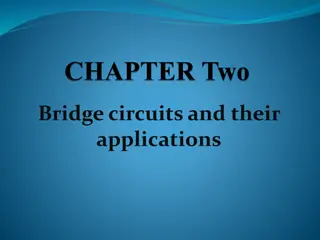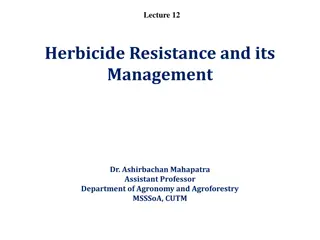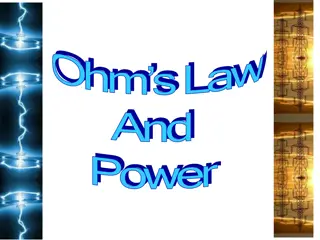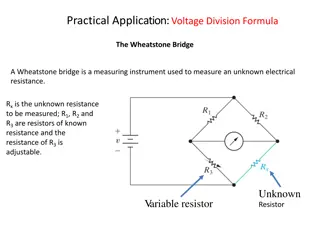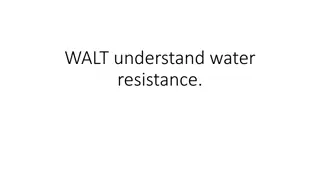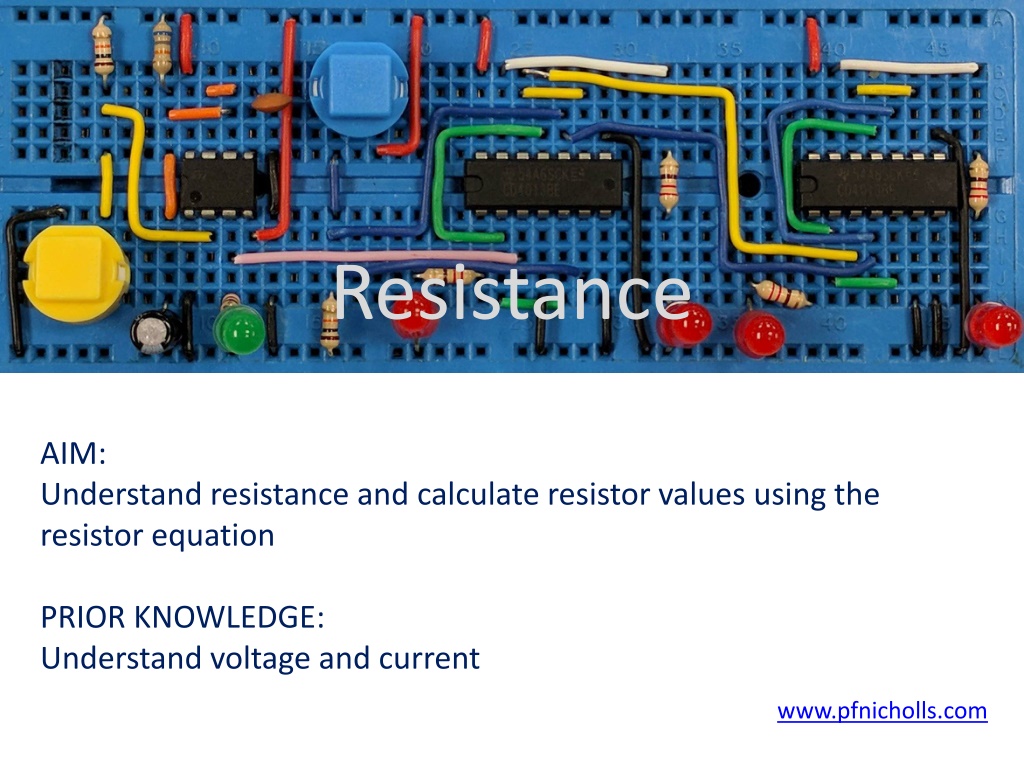
Understanding Resistance in Electrical Circuits
Learn about resistance in electrical circuits, how to calculate resistor values using the resistor equation, and understand the relationship between voltage, current, and resistance. Explore examples and methods for measuring resistance with practical insights. Improve your knowledge of electrical components and circuit design.
Download Presentation

Please find below an Image/Link to download the presentation.
The content on the website is provided AS IS for your information and personal use only. It may not be sold, licensed, or shared on other websites without obtaining consent from the author. If you encounter any issues during the download, it is possible that the publisher has removed the file from their server.
You are allowed to download the files provided on this website for personal or commercial use, subject to the condition that they are used lawfully. All files are the property of their respective owners.
The content on the website is provided AS IS for your information and personal use only. It may not be sold, licensed, or shared on other websites without obtaining consent from the author.
E N D
Presentation Transcript
Resistance AIM: Understand resistance and calculate resistor values using the resistor equation PRIOR KNOWLEDGE: Understand voltage and current www.pfnicholls.com
Resistance Basic Ideas A resistor is a component that opposes the flow of current. A resistor is a passive component, it does not require a power supply to operate, the resistance is a property of the material that the resistor is made from. When current flows through a resistor, it dissipates energy and gets hot - this may or may not be useful! All resistors have a maximum power rating which, if exceeded, results in damage.
Calculating Resistance The actual resistance of a component is determined by how it is constructed i.e. what it is made from. However, in an electrical circuit, resistance is defined as: Resistance = Voltage Current R = V I R = Resistance measured in ohms V = Potential difference across the resistor I = Current flowing through the resistor This is know as the resistor equation. Note, this is notOhm s Law. Ohm s Law is a special case that only applies to fixed value resistors. Always refer to the resistor equation when talking about resistor values.
Examples 1. A potential difference of 5V causes a current of 200mA to flow through a resistor. What is the resistance? R = 25 2. A current of 12A flows through a 4 resistor, what potential difference is causing the current to flow? R = V / I R = 5 / 0.2 3. A potential difference of 120V is applied across a 47k resistor. What current flows in the resistor? V = I x R V = 12 x 4 V = 48V I = 120 / 47x103 = 0.0026A I = 2.6mA I = V / R Note: In question 3, the answer is only given to 2 significant figures as the data in the question is only given to 2 sig fig. Don t put too many digits!
Measuring Resistance The resistance of any component can be determined by measuring the current through the component and the potential difference across the component. The circuit shown can be used to measure potential difference and current. For a fixed value resistor ONLY a graph of Voltage against Current has a gradient equivalent to the resistance.
Measuring Resistance The resistance of a component can be determined using a multimeter set to measure resistance. The component must be removed from the circuit before making a measurement. It is important to select the correct range. For example the 2k setting can only measure values up to (but not including) 2k .
Summary The resistance of a component depends on its physical construction and may, or may not, be a constant value. Resistance is measured in ohms ( ) Resistance is defined as: Resistance = Voltage / Current The resistor equation is: R = V / I Resistance can be measured using a circuit with an ammeter and voltmeter and then using the resistor equation Resistance can conveniently be measured with a multimeter
Questions 1. What is the value of a fixed resistor if a potential difference of 120V causes a current of 25mA to flow through the resistor? 2. What voltage is required to cause 4mA to flow through a resistance of 470k ? 3. What current flows through a heating element of resistance 45 when it is connected to the 230V mains supply?
Answers R = 120 / 25x10-3 1. R = V / I R = 4800 2. V = I x R V = 4x10-3 x 470x103 V = 1880V 3. I = V / R I = 230 / 45 I = 5.1A


